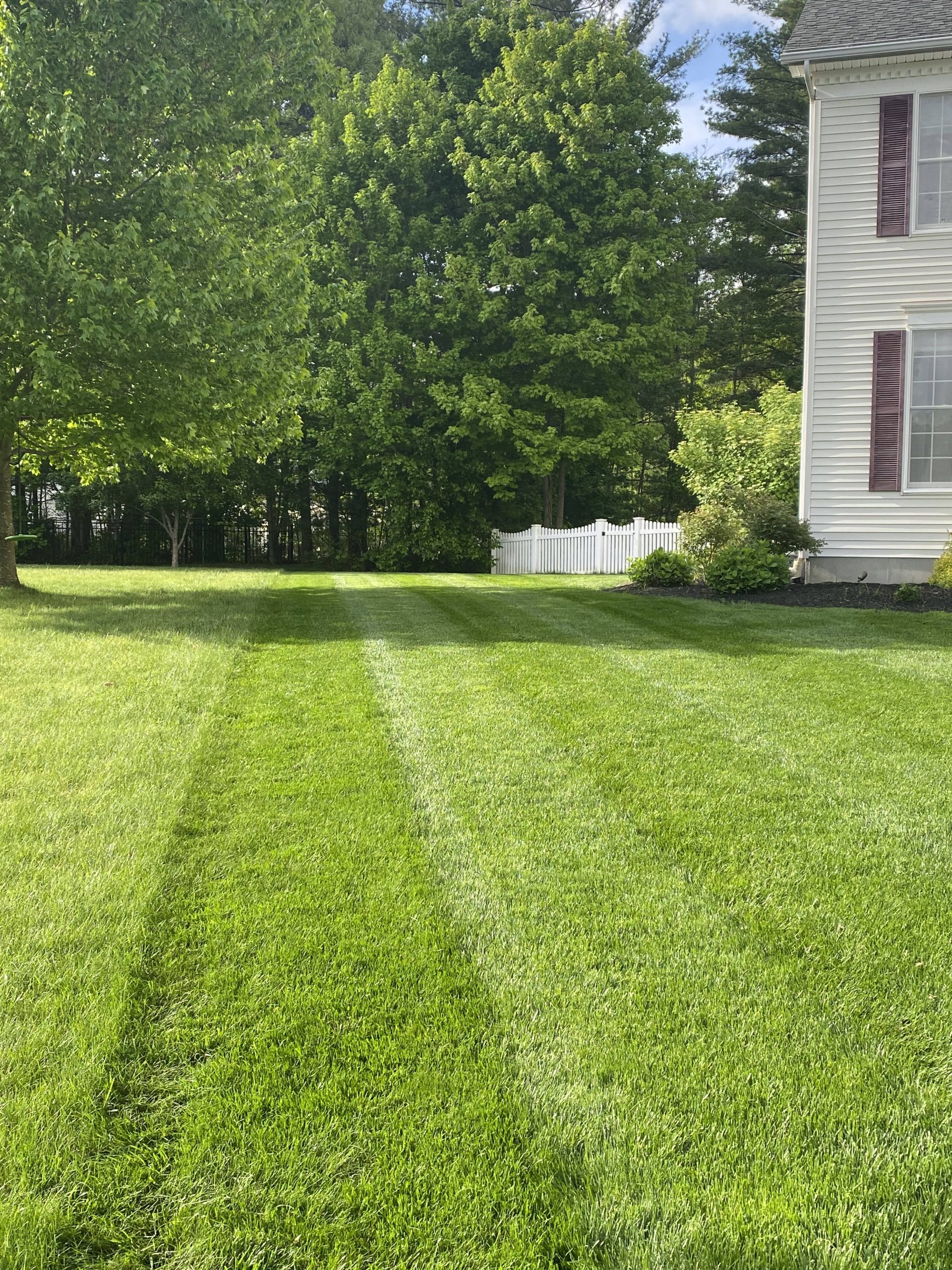To achieve a lush green lawn, you’ll need to take particular care in how you mow. Regular lawn mowing may be a chore, but it can help you boost the health and wellbeing of your landscape when you mow with care. In order to unlock the full potential of your landscape’s grass, you’ll need to practice these following essential lawn mowing tips:
Master the 1/3 Height Rule:
To ensure that your grass grows optimally, you should plan to practice the traditional ⅓ rule for grass height. Cutting more than one third will stress your grass blades and leave them vulnerable to lawn disease. Mowing according to the ⅓ height rule supports grass health and density. In order to practice this lawn mowing tip, you need to:
- Know your grass species: Different grass species thrive at different heights. Cool-season grasses such as fescues prefer 2.5-3.5 inches; warm-season grasses such as Bermuda grass prefer 1-2 inches.
- Avoid scalping: Removing more than a third of the blade length with your lawn mower weakens the grass, leaving it susceptible to weeds and disease development.
- Maintain mowing consistency: Regularly mowing your lawn at the proper height promotes its even growth and can also prevent thatch buildup, which is a dense layer of dead grass that can choke your lawn, preventing optimum air circulation and water absorption..
Mowing Frequency:
There isn’t a precise mowing frequency rule owing to the variables that can impact a mowing schedule. How often you mow your grass depends on several factors such as:
- Seasonality: During the growing season, mow once or twice a week. In fall and winter, mow less frequently (once every 1-2 weeks). During peak warm season, mowing every 4-10 days is a good rule of thumb.
- Grass type: Fast-growing grasses like Kentucky blue grass tend to need more frequent mowing.
- Weather conditions: Frequent rainfall can trigger a grass growing spurt. You may notice that your lawn grows quickly with spring and summer rains. However, avoid mowing wet grass because it leads to clumping and blade damage.
Sharp Blades are Key:
It’s essential to keep your lawn mower blades sharp whether you use riding mowers or a push mower. Dull mower blades tear and rip the grass, which damages the lawn, leaving it more vulnerable to disease. Regularly sharpen your mower’s blades to achieve a clean cut and a lawn. Avoid using dull blades at all costs. Mowing your lawn with sharp mower blades will make cutting grass easier and help you create a beautiful lawn that’s the envy of the neighborhood. If you own a riding lawn mower, you might want to have it professionally serviced. Many residents sharpen the blades of their push mower on their own.
Don’t Mow Wet Grass:
Wet grass is a no-mow zone. Wait to mow until your yard dries completely before you mow. Wet grass creates a mess, clogs the mower deck, and damages the grass blades. You won’t be able to achieve an attractive lawn if you mow wet grass. Mowing wet grass can result in a ragged-looking mow and the resulting damaged grass blades will become more susceptible to fungal disease. The wheels of your mower can leave wheel ruts in a wet lawn, which damage both your lawn and the soil. There’s also more danger for operators because of slip risks and you can even damage your lawn mower. Wet grass clippings can clog your mower and reduce the neat look of your lawn, so be sure to have dry grass before you mow the lawn.


Varying Your Mowing Pattern:
Have you ever noticed a lawn that seems to have grass that leans? Leaning grass blades can occur when you mow your lawn the same way every time. Instead, mow your grass in different directions (horizontal, vertical, diagonal) to prevent soil compaction and encourage even grass growth. Mowing with changed patterns will result in more upright growing grass blades too, helping you get the attractive lawn you’re striving for. Some people prefer to create a mowing pattern like checkerboard or circular patterns. This is fine, but be sure, again, to change up the pattern and follow the golden rules like mowing high, mowing dry, and mowing with sharp blades in order to keep your grass healthy.
Clean Your Lawn Mower Deck:
Keeping your lawn mower deck clean is more than just an aesthetic practice. There are good reasons to clean the mower deck after you mow and clean up lawn clippings. Mowing inevitably churns up weeds and other plants that you likely don’t want to spread throughout your lawn. So, after each mowing, remove the grass clippings. This will help to reduce the spread of lawn disease and weeds. Not cleaning your mower can reduce its optimum function. Old grass clippings and landscape debris can clog your mower and cause corrosion; grass clippings can also spread weed seeds to other areas of your lawn. To ensure your mower mows your grass properly, be sure to keep it clean and well maintained. The same holds true whether you use a push mower or riding lawn mower.
Bonus Tips for Lawn Mowing Tips Success:
If you’re a lawn-care overachiever, you should embrace the following helpful tips too. They can help you keep your lawn vibrant green and healthy.
- Adjust lawn mower height: Raise the mowing deck height during hot summer months for shade and moisture conservation.
- Edge lawn regularly: Maintain your lawn’s clean borders for a neat, polished look.
- Mind obstacles in your yard: Be mindful of sprinklers, trees, and other objects while mowing to avoid damaging your mower and lawn grass plants.
- Choose the right lawn mower: If you want to excel in lawn care, choose lawn mowers that are ideal for you. A riding mower may be more convenient, but it’s ideally suited to larger expanses of lawn. Push lawn mowers come in many styles. Find one that’s convenient for you to use so that lawn care isn’t overly challenging for you to achieve.
- Service your mower regularly: Keep your lawn looking its best by keepinng your mower in premium working condition.
Understanding the 1/3 Rule and Best Practices:
Cutting more than a third of the grass blade in one go stresses the grass blades, leading to a dull, unhealthy appearance. To keep the ⅓ height rule for your entire lawn, you should:
- Set the lawn mower to the highest height setting and bag the grass clippings.
- Mow grass in the opposite direction at a lower setting to gradually regain the desired lawn height.
- Apply light fertilizer to aid in lawn recovery after using your mower–and a healthier lawn.
Beyond the 1/3 rule, remember these best mowing practices:
- Frequent mowing: Encourages healthy grass growth and prevents excess clippings.
- Mower height adjustment: Raise it during hot weather to shade the soil, which helps conserve moisture and prevents your lawn from getting stressed.
- Clean mower blades: Ensures a clean mowing cut and minimizes stress for your lawn.
By following these lawn care tips and best lawn mowing practices, you can maintain a healthy and resilient lawn that brims with curb appeal. Proper lawn mowing isn’t just about aesthetics, though. It’s about nurturing a healthy ecosystem in your own backyard. By mowing your lawn with these tips in mind, your lawn can flourish during mowing season.
FAQs: How Often Should You Mow Your Lawn? Essential Lawn mowing tips
What’s the mow height for different grass types?
The optimal mowing height for various lawn grass types is:
- Kentucky bluegrass: 3.5 inches
- Perennial ryegrass: 3.5 inches
- Tall fescue: 4 inches
Adjust your lawn mower blade to the proper height so you can abide by the one third rule.
How often should you mow your grass?
During peak growing season, you should mow 1-2 times per week for fast-growing lawns like Kentucky bluegrass. For slow-growing lawns, once per week usually suffices. During the off season, you can mow once or twice a month depending on your grass type.
Does frequent mowing result in a thicker lawn?
Yes, if you mow your lawn frequently, you can promote tillering and lateral grass growth, which leads to a denser healthy lawn.
Is a sharp mower blade important?
Yes. You should always be sure you have a sharp mower blade before you mow a lawn. Otherwise, you can damage the grass blades, which can undermine your healthy lawn. Sharpen mower blades to keep your grass in healthy condition and to maintain a perfect lawn.


